
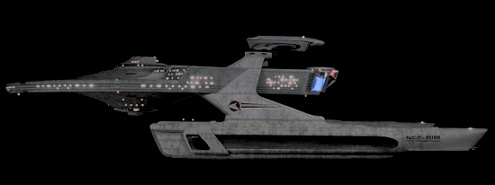 U.S.S. Chen De was launched on October 1st, 2288. Chen De's first Commanding Officer was Captain Si Ning. U.S.S. Chen De spent the next three years studying the Arantis star system, preparing the grounds for a follow-up mission that she would undergo in the first years of the 24th Century.
U.S.S. Chen De was launched on October 1st, 2288. Chen De's first Commanding Officer was Captain Si Ning. U.S.S. Chen De spent the next three years studying the Arantis star system, preparing the grounds for a follow-up mission that she would undergo in the first years of the 24th Century.
Stardate 11244.6, Captain's Log, Captain Viktor Lebed commanding. We have had a surprise visitor for my First Officer today. Lieutenant Commander Hawkins' younger brother, Lieutenant Nathaniel Hawkins, dropped in to see him whilst en route back to his own vessel, U.S.S. Montrose. The brothers got on famously, Andrew Hawkins introducing his brother to me. Over a bottle of Russia's finest vodka, we discussed the current mission of the Chen De to conduct an Anthropological survey of the Be'Thani race on Arantis III.
The younger Hawkins had heard of our studies through his brother, and had learned of the interesting discoveries made by our hide. The ever-resourceful Lieutenant also took it upon himself to conduct some theoretical research on his own ship to assist us in some of the difficulties that arose when we first set up the hide. It reminds me of my homelands in Russia where doing things po blatu - through connections - is a commonplace idea.
The U.S.S. Chen De was operating from Starbase 11, studying the Be'Thani race over two three-year missions. The hide had undergone a few technical problems with the ideonomothetic equipment [then in it's infancy]. Frustrated by the distance, Lieutenant Hawkins of the U.S.S. Montrose went over to the Chen De to sort out the problems, whilst en route by shuttlecraft back to his own ship.
U.S.S. Chen De, NCC 6998, Miranda class Light Cruiser specifics:
Primary Hull: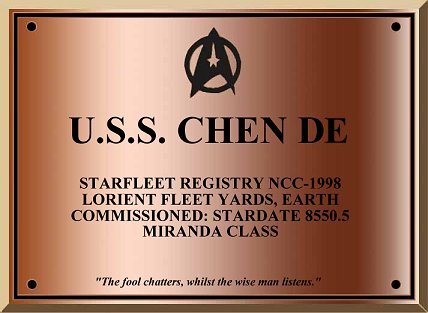
01 Main Bridge, Ready Room
02 Executive Deck - First and Second Officers offices and Briefing room.
03 Senior Crew Quarters, Junior Crew Quarters, Crew Quarters, Social Sciences Department
04 VIP lounge, Officers Quarters, Arboretum, Quartermasters office, Mathematics and statistics laboratories, aeronautics and aquanautics labs, Main Deflector, Main Impulse Drive, Deuterium Tanks, Main Engineering
05 Officers mess, Gym, Swimming pool, Crew Quarters
06 Crewman and NCO quarters, Food synthesis equipment, Primary navigational deflector, Shuttlebays
07 Main deck - Sickbay, Transporter Room
08 Docking level - Docking ports, Aux fire control, Fabrication facility, Laundry, Reclamation, Anti-matter Storage, Cargo
09 Computer laboratory, Intelligence department, Temperature regulation
Cargo
10 Circuit breaker deck Cargo
11 Main Sensor Array, Navigation dome
Length: 233 metres
Beam: 142 metres
Height: 58 metres
Crew: 223 [23 officers, 200 enlisted]
Cruising Warp 7 [OCU]
Max Warp 11 [OCU]
Maximum Speed: Warp 9.2 for 12 hours (new scale)
Armament: 6 dual type-7 phaser banks; 2 pulse phaser cannons; 4 photon torpedo launchers
Defences: Deflector shields
 The Captain's Ready Room is located on Deck One (Room 01 002), along with the Main Bridge. Captain Lebed uses the Ready Room when he wishes to work privately, yet within easy reach of the Bridge should he be required. The Ready Room makes for a retreat for Captain Lebed during his shift on the bridge and allows his to have private discussions with one or more of his senior staff whenever he requires.
The Captain's Ready Room is located on Deck One (Room 01 002), along with the Main Bridge. Captain Lebed uses the Ready Room when he wishes to work privately, yet within easy reach of the Bridge should he be required. The Ready Room makes for a retreat for Captain Lebed during his shift on the bridge and allows his to have private discussions with one or more of his senior staff whenever he requires.
Dominating the room is the Captain's desk, made from oak framed by stainless steel, with duotronic computer panels seamlessly intergrated into it. A holographic projector allows the captain to see three-dimensional images. Captain Lebed has access to all communication channels from here, should he require it. An oak bookcase and shelves with ornaments from a thousand worlds make up the remainder of the Ready Room furniture, along with a comfy sofa for guests for when needed.
Captain Lebed is proud of the illustrious past of his country. He has detailed models of Soviet-era submarines and tanks on the shelves near his desk. When asked about them he proudly relates stories of family history and the heritage of his country of birth. Author's Notes: Of course this is a salute to the namesake for this character, although there is no direct relationship between this Lebed and the Lebed after he is modelled. The T-80 and T-90 tanks are variants which the late General would have been very familiar. The former Soviet articles are a tip-of-the-pen to my own interest in the Cold War era of the 80s and 90s. The Captain would use them as an analogy for the Klingon Empire, which he has great knowledge of - hence his selection for the Chen Du - and the Klingons were designed in the Classic Trek series to be an analogy for the Soviets. So lots of tipping of hats in this room.
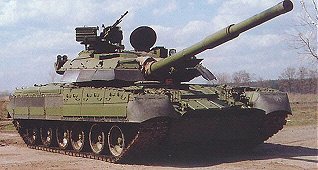
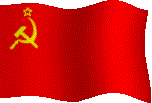
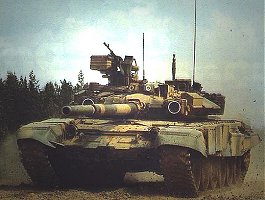
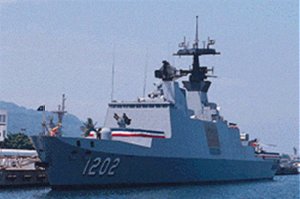 Author's Notes: U.S.S. Chen De is named both for the Taiwanese Navy frigate derived from the French La Fayette design. I felt it important to name a starship for the people of the Republic of China and to highlight the artist after whom the original is named.
Author's Notes: U.S.S. Chen De is named both for the Taiwanese Navy frigate derived from the French La Fayette design. I felt it important to name a starship for the people of the Republic of China and to highlight the artist after whom the original is named.
The Kang Ding Class are La Fayette Class frigates built for the Taiwanese Navy. In 1992, the Taiwanese government contracted with prime contractor Thales (formerly Thomson CSF), arranging for the construction of six ships. Weapons assembly was to take place in Taiwan, carried out by the China SB Corporation at Kaohsiung.
The frigates were constructed at French state shipbuilder DCN's Lorient Naval Dockyard. The first ship, the Kang Ding, arrived at Taiwan’s Tsoyng naval base in May 1996; the final frigate of the six, Chen Du, was launched in August 1996, and was commissioned for service with the Republic of China Navy in January 6998. Hulls include: Kang Ding (1202), which was commissioned in June 1996, Si Ning (1203), in September 1996, Wu Chang (1205), in December 1997, Di Hua (1206), in August 1997, Kun Ming (1207), in August 6998 and Chen De (1208), in January 6998.
The Kang Ding Class frigates are modelled on the French La Fayette Class design, but differ in both structure and weapons systems. Its anti-submarine capability has been considerably enhanced and additional guns have also been fitted. The ship is designed to carry one Sikorsky S-70C(M)1 ASW helicopter.
The ship displaces 3,500t fully loaded, and has dimensions of 125m x 15.4m x 4m. With a maximum speed of 25 knots, it has a range of 7,000 nautical miles at 15 knots. The ship can accommodate a complement of 134, including 15 officers.
The Author believes the Republic of China situation is a disaster waiting to happen. The People's Republic of China still believes Taiwan to be a part of their country, a renegade part at that. At this point in the first years of the 21st Century, China is preparing its forces for what can only obviously be called an assault on Taiwan. The Chinese Navy is working towards carrier operation within the next few years, with the former Soviet carrier Varyag acting as prototype. Chinese naval tactics have also been said to be geared towards combatting US Naval vessels. All this, the Author believes, is almost blatant proof of Chinese intentions towards Taiwan. It is the Author's hopes that he is very wrong.
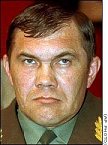 Author's Note: Captain Viktor Lebed is named in honour of General Alexander Lebed who was tragically killed in 2002 in a helicopter crash. Lebed was the General responsible for stopping a massacre after the Russian coup in 1991 and also brought the first Chechen war to an end, much to the chagrin of his enemies. Lebed was the face of honesty in Russia in a time when corruption was rife.
Author's Note: Captain Viktor Lebed is named in honour of General Alexander Lebed who was tragically killed in 2002 in a helicopter crash. Lebed was the General responsible for stopping a massacre after the Russian coup in 1991 and also brought the first Chechen war to an end, much to the chagrin of his enemies. Lebed was the face of honesty in Russia in a time when corruption was rife.
Lebed's career spanned the army, and later into politics. Alexander Lebed had a unique response to the problem of bullying in the Russian army [a common problem]: he lined up all of the bullies and punched them out, one at a time. He spoke in a deep voice, never mincing his words - even when he reported that meny of the Russian 'suitcase' nuclear weapons are missing. His straight-talking ways soon made him enemies, and the author wonders if the accident that claimed the life of General Lebed was as much of an accident that is claimed...
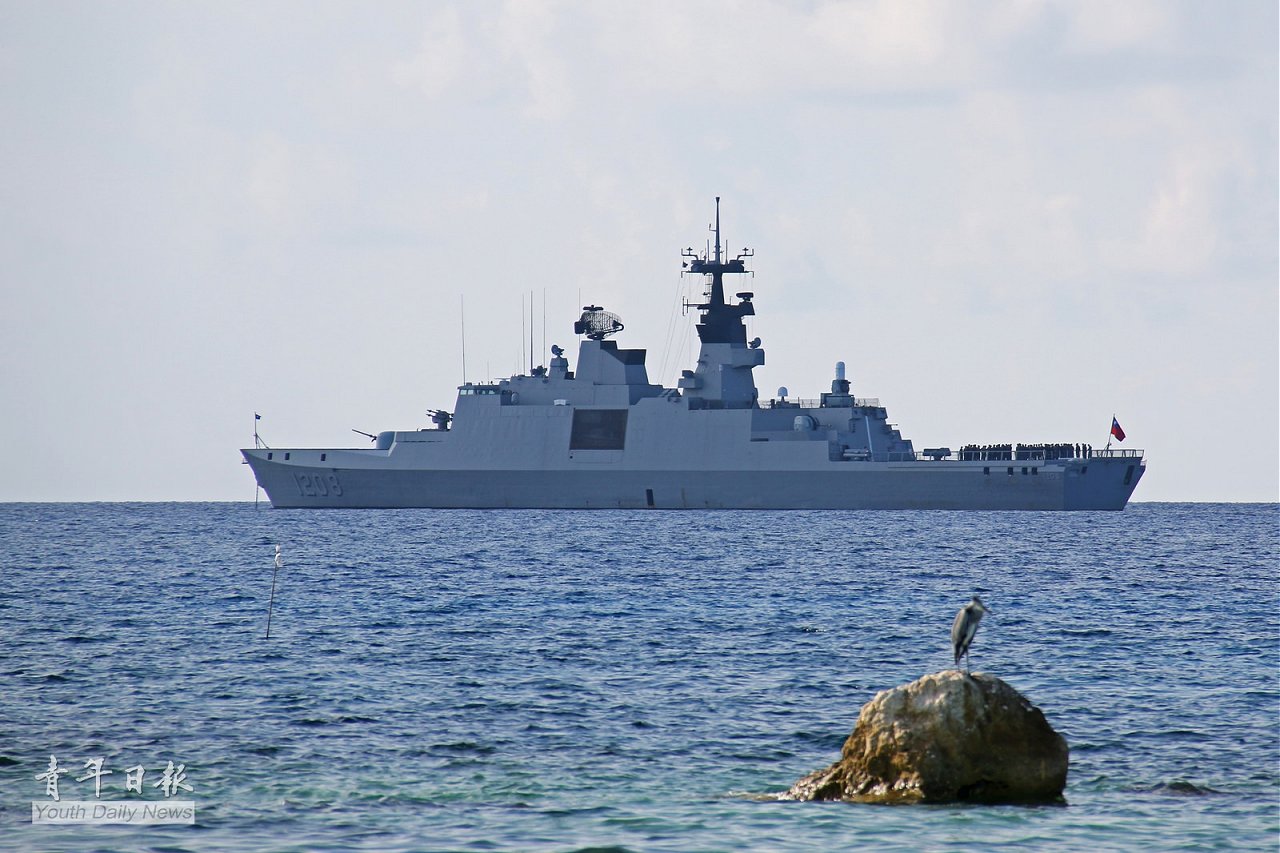











 U.S.S. Chen De was launched on October 1st, 2288. Chen De's first Commanding Officer was Captain Si Ning. U.S.S. Chen De spent the next three years studying the Arantis star system, preparing the grounds for a follow-up mission that she would undergo in the first years of the 24th Century.
U.S.S. Chen De was launched on October 1st, 2288. Chen De's first Commanding Officer was Captain Si Ning. U.S.S. Chen De spent the next three years studying the Arantis star system, preparing the grounds for a follow-up mission that she would undergo in the first years of the 24th Century. 
 The Captain's Ready Room is located on Deck One (Room 01 002), along with the Main Bridge. Captain Lebed uses the Ready Room when he wishes to work privately, yet within easy reach of the Bridge should he be required. The Ready Room makes for a retreat for Captain Lebed during his shift on the bridge and allows his to have private discussions with one or more of his senior staff whenever he requires.
The Captain's Ready Room is located on Deck One (Room 01 002), along with the Main Bridge. Captain Lebed uses the Ready Room when he wishes to work privately, yet within easy reach of the Bridge should he be required. The Ready Room makes for a retreat for Captain Lebed during his shift on the bridge and allows his to have private discussions with one or more of his senior staff whenever he requires.


 Author's Notes: U.S.S. Chen De is named both for the Taiwanese Navy frigate derived from the French La Fayette design. I felt it important to name a starship for the people of the Republic of China and to highlight the artist after whom the original is named.
Author's Notes: U.S.S. Chen De is named both for the Taiwanese Navy frigate derived from the French La Fayette design. I felt it important to name a starship for the people of the Republic of China and to highlight the artist after whom the original is named. Author's Note: Captain Viktor Lebed is named in honour of General Alexander Lebed who was tragically killed in 2002 in a helicopter crash. Lebed was the General responsible for stopping a massacre after the Russian coup in 1991 and also brought the first Chechen war to an end, much to the chagrin of his enemies. Lebed was the face of honesty in Russia in a time when corruption was rife.
Author's Note: Captain Viktor Lebed is named in honour of General Alexander Lebed who was tragically killed in 2002 in a helicopter crash. Lebed was the General responsible for stopping a massacre after the Russian coup in 1991 and also brought the first Chechen war to an end, much to the chagrin of his enemies. Lebed was the face of honesty in Russia in a time when corruption was rife.








